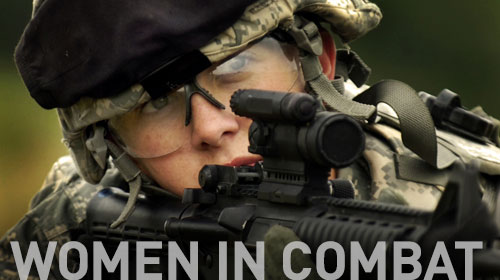Military Reveals Plans For Integrating Women Into Combat Units, But Many Questions Remain


On January 24, 2013, we saw a great victory for U.S. servicewomen when the Department of Defense announced it was ending the ban on women serving in combat units and occupational specialties. As the Pentagon and the armed services begin implementing the change in policy, there are many issues that must be resolved, and we'll be keeping a close eye on the process. In an ongoing blog series, we will bring you voices of military experts, veterans, and other stakeholders who will discuss these issues and the need to fully integrate women in the armed forces.
Yesterday, the Pentagon made public the plans that each branch of the military submitted to the Secretary of Defense explaining plans for implementing the Secretary's January repeal of the 1994 combat exclusion policy, which barred women from serving in direct ground combat units. The Army, Navy, Marine Corps, Air Force, and Special Operations Command all submitted plans explaining how, when, and to what extent they plan to integrate women into career fields and specific jobs that were previously men-only.
There's much to applaud in these plans, but they also raise concerns and many questions, and they underscore the need for more information. A few highlights:
- The Air Force, where 99 percent of positions are currently open to women, says that it will open the rest no later than January of 2016. In yesterday's press conference, however, the Air Force spokesperson indicated that at least some Air Force positions are controlled by the Special Operations Command, which will have the final say as to whether women can compete for them.
- The Army said that its mission is to open all remaining closed military occupational specialties no later than January 2016, and it listed infantry positions among those it would open. It also discussed opening the prestigious Ranger Course. We're glad to see that the Army also discussed providing junior officers and non-commissioned officers the opportunity to reclassify into previously closed occupations. More details about these opportunities are important, so that the generation of women who have already proven themselves in combat on the battlefield understand which combat leadership positions they can compete for.
- The Marine Corps did not commit to opening all positions; on the contrary, it said only that at the end of a research phase, it would reserve the right to either keep open or request an exception to policy – the new policy of opening all positions to women – to close certain specialties and units. The Corps is testing a sample of 400 male and female Marines on various physical tests in order to inform its decisions.
- The Special Operations Command plan does not offer much information about which positions will be open. At the press conference, the spokesperson discussed concerns about the cultural ramifications of opening these elite units to women.
It's time to put an end to categorical exclusions. Instead of keeping whole career fields closed to women, the time has come to let women compete for these jobs. As the plaintiffs in the ACLU lawsuit challenging the 1994 combat exclusion policy have made clear, many women have already served valiantly in combat – often under less than ideal conditions, often with units that weren't their "official" units, often without having participated in full training with those units. And yet they rose to the occasion and became indispensable to the combat troops they worked with. Their courage and competence must have been among the factors that led the Secretary of Defense to rescind the policy this past January and order the military branches to come up with plans for integrating women into combat units.
Battle-seasoned servicewomen will continue to leave the military if the residual effects of the combat exclusion policy continue to mean that they can't compete for combat leadership positions and make the full contribution they are capable of making. Our all-volunteer force can ill afford this talent drain of experienced fighters. ALL service branches should make clear that women will be allowed to train and compete for closed positions.
Learn more about combat exclusion and other civil liberties issues: Sign up for breaking news alerts, follow us on Twitter, and like us on Facebook.

